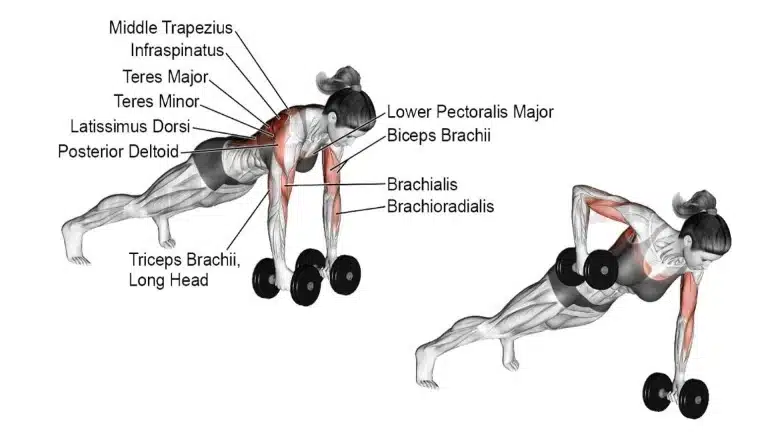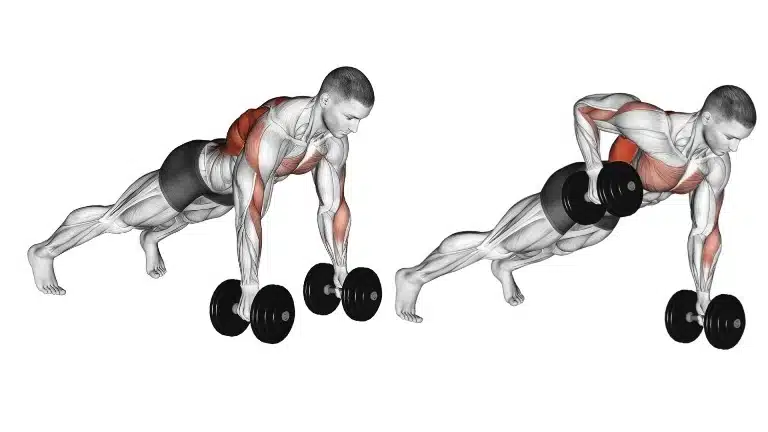Renegade Row Push-Ups is a full-body exercise that combines a push-up with a row using dumbbells or other weights.
It simultaneously targets multiple muscle groups, making it an efficient use of time for those looking to build strength and tone their upper body.
The exercise’s movement requires coordination between the upper and lower body and helps develop better balance and control.
The push-up portion works the chest, anterior deltoids, and triceps as the primary movers. Rowing one arm upwards trains the latissimus dorsi, rhomboids, traps, and biceps.
The core, particularly the oblique muscles, transverse abdominis, and hip stabilisers, must work harder to prevent rotation and maintain the plank position.
This is not a beginner’s exercise. First, perfect solid plank hold for a minimum of 30–60 seconds with good form.

Push-Up To Renegade Row Muscles Worked
The Renegade row push-up is a compound exercise that targets multiple muscle groups, including:
They primarily work the Back, chest muscles (pectoralis major and minor), triceps, and shoulders (deltoids).
They also engage the core muscles, such as the serratus anterior, which help stabilize the body during exercise.
Furthermore, it is worth mentioning that the legs and glutes are indirectly targeted during push-ups with renegade row.

Know More: Push-Ups: How-To, Muscle Worked, Benefit, Variations
How To Do Dumbbell Renegade Row Push Up
- Place two hexagonal dumbbells on the floor, slightly wider than shoulder-width apart (about 2–3 feet).
- Choose a weight that allows you to complete the row portion with control while maintaining plank stability. Start lighter than you think you need.
- Kneel behind the dumbbells. Place your hands firmly on the handles, gripping them in a neutral position (palms facing each other). Extend your legs back one at a time to get into a high plank position, balancing on the balls of your feet.
- Bend your elbows and lower your chest towards the floor until your chest is close to the dumbbells, leveraging that increased range of motion.
- Keep your elbows tracking back at a slight angle (around 45 degrees relative to your torso), not flaring straight out.
- Exhale and push through the dumbbells. Return to the starting high plank position.
- Once back in the stable high plank, subtly shift your weight onto the supporting arm (which will not be rowing).
- While keeping your hips and torso as stable and square to the floor as possible, pull one dumbbell upwards towards your rib cage.
- Drive your elbow back and up. Pull the dumbbell until your hand is near your torso. This will ensure a good contraction in your upper back muscles.
- Actively resist the urge to rotate your torso or hips. Your core, especially the obliques on the supporting side, is working intensely to prevent twisting.
- Slowly and with control, lower the dumbbell back to the floor, returning it to its original position under your shoulder. Inhale during the descent.
- Once the dumbbell is safely back on the floor, immediately re-establish your rigid, stable high plank position with both hands supporting your weight.
- Repeat the same steps on the opposite side. Shift weight slightly to the new supporting arm, brace the core, pull the dumbbell, resist rotation, and control the descent back to the floor.
- One Push-Up followed by a Row on each side counts as one complete sequence (Push-Up + Left Row + push-up + Right Row).
- Alternative Renegade Row Push-Up sequence is Push-up -> Row (Side 1) -> Return -> Row (Side 2) -> Return. This constitutes one combined unit of work.
Tips and Techniques
Here are some tips and techniques to help you perform it correctly and safely:
- Keep your body straight and rigid from the crown of your head to your heels. Avoid sagging in the hips or piking up.
- Activating your core prevents sagging hips or twisting, protects your lower back and maximises muscle engagement.
- When rowing, focus on squeezing your shoulder blade towards your spine, and when pushing up, focus on engaging the chest and triceps.
- Use hex dumbbells to prevent rolling, unlike round ones, which can roll and throw off your balance.
- Start with only your body weight before adding weights. As you progress, you can increase the weights or reps to make the exercise more challenging.
- Widen your feet (wider than hip width) to increase stability initially. As you get stronger, you can narrow your stance to increase the challenge.
- Start with 2–3 sets of 8–12 reps of the exercise or as many as possible while maintaining proper form. As you get stronger, you can do more sets and reps.

Variations and Modifications of Renegade Row Push-Up
Variations are a great way to mix up your renegade row push-up routine and keep it fresh.
With a bit of creativity and variety, you will never tire of mastering this classic move!
1. Knee Renegade Row Push Up
The Kneeling Renegade Row Push-Up is a great beginner-friendly version of the full exercise done from your feet. It’s perfect for helping you relax as you transition between the push-up and the row.
The push-up part is a bit easier since you’re moving less body weight. This allows you to really focus on your form and how deep you go while using the dumbbell grip.
2. Renegade Row Push-Up With Kettlebell
The setup for the renegade row push-ups with kettlebells is similar to a standard push-up but with the added challenge of stability from the kettlebells.
The use of kettlebells allows for more variety and variation in this exercise, as kettlebells offer a wider range of motion and different grip options on the handle.
The kettlebells also require more engagement of the core, which will increase the effectiveness of the exercise on the core.

Manish is a NASM-certified fitness and nutrition coach with over 10 years of experience in weight lifting and fat loss fitness coaching. He specializes in gym-based training and has a lot of knowledge about exercise, lifting technique, biomechanics, and more.
Through “Fit Life Regime,” he generously shares the insights he’s gained over a decade in the field. His goal is to equip others with the knowledge to start their own fitness journey.
